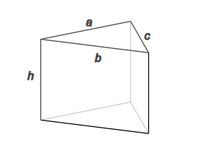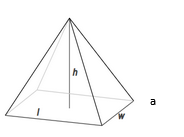
How do you find the surface area of a triangular prism and a pyramid?
Answer
525.3k+ views
Hint: Here in this question, we have to find the surface area of a triangular prism and a pyramid. To find the surface area of a triangular prism, can be found by adding the area of the lateral sides to the area of the bases and the surface area of any pyramid can be found by adding the surface area of the base to the surface area of the lateral faces.
Complete step-by-step answer:
The surface area of a solid object is a measure of the total area that the surface of the object occupies.

The surface area of a triangular prism
A triangular prism is a polyhedron, (three-dimensional shape) made up of two triangular bases and three rectangular sides. Like other Prisms, the two bases here are parallel and congruent to each other. It has 5 faces, 6 vertices and 9 edges in total.
To find the surface area of a triangular prism, you first need to find the area of the lateral sides, then you need to find the area of the bases. Finally, you need to add these two areas together to find the total surface area.
The lateral area of a triangular prism. The formula is \[ \Rightarrow L = Ph \]------(1)
Where,
\[L\] equals the lateral area of the prism
\[P\] equals the perimeter of one base (The perimeter of one base. The base is a triangle, so it will have three sides. The area of the perimeter of a triangle is
\[Perimeter = a + b + c\] , where \[a\] , \[b\] , and \[c\] are the length of each side of the triangle.)
\[h\] equals the height of the prism. (The height of the prism into the lateral area formula. The height of the prism is the same as the length of the side of any lateral face that is not connected to the base.)
The lateral area of a prism is the surface area of all sides, or faces, that are not the base
The bases of a triangular prism are triangles, you will use this formula to calculate their area. The formula for the area of a triangle is
\[ \Rightarrow A = \dfrac{1}{2}bh\] ,
where \[A\] equals the area of the triangle,
\[b\] equals the base of the triangle, and
\[h\] equals the height of the triangle.
The base for another side of the triangle. the base is the side perpendicular to the height.
By the definition the surface area of a prism can be written as
\[ \Rightarrow SA = L + 2B\] -------(2)
Substitute one in (2), then
\[ \Rightarrow SA = Ph + 2B\]
Where,
\[SA\] equals the surface area of the prism,
\[B\] equals the area of one base means the area of one side of the triangle.

II.The surface area of a triangular Pyramid
Triangular pyramids are formed solely from triangles. The 3 triangular sides slant upwards to form the triangular base. As it is formed from four triangles, a triangular-based pyramid is also called a tetrahedron. Triangular-based pyramids have 6 edges, 3 are along the base and 3 are extending up from the base.
The surface area of any pyramid can be found by adding the surface area of the base to the surface area of the lateral faces. The basic formula for the surface area of any pyramid, regular or irregular, is
\[Total{\text{ }}Surface{\text{ }}Area = Base{\text{ }}Area + Lateral{\text{ }}Area\] .
The formula for the surface area of a regular pyramid. The formula is
\[ \Rightarrow SA = \dfrac{1}{2}L + B\]
\[ \Rightarrow SA = \dfrac{1}{2}\left( {P \times h} \right) + B\]
Where, \[SA\] equals the total surface area of the pyramid,
\[P\] equals the perimeter of the base,
\[h\] equals the slant height of the pyramid “slant height” is the diagonal distance from the apex of the pyramid to the edge of the base, and
\[B\] equals the area of the base.
Note: To determine the surface area of a prism and pyramid we have a standard formula. Since both shapes have the shape of a triangle we will not consider the area of a triangle. Using these formulas we can determine the surface area of the prism and pyramid where its dimensions are mentioned.
Complete step-by-step answer:
The surface area of a solid object is a measure of the total area that the surface of the object occupies.

The surface area of a triangular prism
A triangular prism is a polyhedron, (three-dimensional shape) made up of two triangular bases and three rectangular sides. Like other Prisms, the two bases here are parallel and congruent to each other. It has 5 faces, 6 vertices and 9 edges in total.
To find the surface area of a triangular prism, you first need to find the area of the lateral sides, then you need to find the area of the bases. Finally, you need to add these two areas together to find the total surface area.
The lateral area of a triangular prism. The formula is \[ \Rightarrow L = Ph \]------(1)
Where,
\[L\] equals the lateral area of the prism
\[P\] equals the perimeter of one base (The perimeter of one base. The base is a triangle, so it will have three sides. The area of the perimeter of a triangle is
\[Perimeter = a + b + c\] , where \[a\] , \[b\] , and \[c\] are the length of each side of the triangle.)
\[h\] equals the height of the prism. (The height of the prism into the lateral area formula. The height of the prism is the same as the length of the side of any lateral face that is not connected to the base.)
The lateral area of a prism is the surface area of all sides, or faces, that are not the base
The bases of a triangular prism are triangles, you will use this formula to calculate their area. The formula for the area of a triangle is
\[ \Rightarrow A = \dfrac{1}{2}bh\] ,
where \[A\] equals the area of the triangle,
\[b\] equals the base of the triangle, and
\[h\] equals the height of the triangle.
The base for another side of the triangle. the base is the side perpendicular to the height.
By the definition the surface area of a prism can be written as
\[ \Rightarrow SA = L + 2B\] -------(2)
Substitute one in (2), then
\[ \Rightarrow SA = Ph + 2B\]
Where,
\[SA\] equals the surface area of the prism,
\[B\] equals the area of one base means the area of one side of the triangle.

II.The surface area of a triangular Pyramid
Triangular pyramids are formed solely from triangles. The 3 triangular sides slant upwards to form the triangular base. As it is formed from four triangles, a triangular-based pyramid is also called a tetrahedron. Triangular-based pyramids have 6 edges, 3 are along the base and 3 are extending up from the base.
The surface area of any pyramid can be found by adding the surface area of the base to the surface area of the lateral faces. The basic formula for the surface area of any pyramid, regular or irregular, is
\[Total{\text{ }}Surface{\text{ }}Area = Base{\text{ }}Area + Lateral{\text{ }}Area\] .
The formula for the surface area of a regular pyramid. The formula is
\[ \Rightarrow SA = \dfrac{1}{2}L + B\]
\[ \Rightarrow SA = \dfrac{1}{2}\left( {P \times h} \right) + B\]
Where, \[SA\] equals the total surface area of the pyramid,
\[P\] equals the perimeter of the base,
\[h\] equals the slant height of the pyramid “slant height” is the diagonal distance from the apex of the pyramid to the edge of the base, and
\[B\] equals the area of the base.
Note: To determine the surface area of a prism and pyramid we have a standard formula. Since both shapes have the shape of a triangle we will not consider the area of a triangle. Using these formulas we can determine the surface area of the prism and pyramid where its dimensions are mentioned.
Recently Updated Pages
Master Class 12 Business Studies: Engaging Questions & Answers for Success

Master Class 12 Economics: Engaging Questions & Answers for Success

Master Class 12 English: Engaging Questions & Answers for Success

Master Class 12 Maths: Engaging Questions & Answers for Success

Master Class 12 Social Science: Engaging Questions & Answers for Success

Master Class 12 Chemistry: Engaging Questions & Answers for Success

Trending doubts
Which places in India experience sunrise first and class 9 social science CBSE

Fill the blanks with the suitable prepositions 1 The class 9 english CBSE

Write the 6 fundamental rights of India and explain in detail

Difference Between Plant Cell and Animal Cell

What is pollution? How many types of pollution? Define it

What is the full form of pH?




